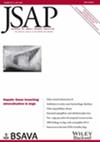Use of human intravenous immunoglobulin for the treatment of 12 dogs with newly diagnosed malignant disease and presumed secondary immune-mediated thrombocytopenia
Abstract
Objectives
To evaluate the safety and efficacy of human intravenous immunoglobulin in dogs with newly diagnosed malignancy and presumed secondary immune-mediated thrombocytopenia.
Materials and Methods
Twelve client-owned dogs with newly diagnosed malignant disease and presumed secondary immune-mediated thrombocytopenia were prospectively enrolled to receive a single infusion of human intravenous immunoglobulin at a dose of 0.5 to 1 mg/kg intravenous over 8 hours. A complete treatment response was defined as a platelet estimation of ≥40,000 platelets/μL within 24 hours and a partial response within 48 hours from the completion of human intravenous immunoglobulin infusion. No treatment response was defined as a platelet estimation remaining <40,000 platelets/μL over 48 hours from the completion of the human intravenous immunoglobulin infusion. This pilot study had a prospective, open-label, uncontrolled design.
Results
Out of the 12 enrolled dogs, seven completed the study. A complete treatment response to human intravenous immunoglobulin was identified in one lymphoma dog and a partial response was noted in another lymphoma dog. The remaining 10 dogs had no response to human intravenous immunoglobulin. No clinically relevant adverse reactions to human intravenous immunoglobulin occurred in any of the 12 initially enrolled dogs during the infusion and over a 3-month follow-up period for the seven surviving dogs.
Clinical Significance
The results of this study suggest that the use of human intravenous immunoglobulin in dogs with newly diagnosed malignant disease and presumed secondary immune-mediated thrombocytopenia appears safe, but not effective for the treatment of thrombocytopenia. Larger multi-centre, prospective, double-blinded, placebo-controlled, outcome-based, malignancy-specific studies are needed to further evaluate these preliminary findings.

 求助内容:
求助内容: 应助结果提醒方式:
应助结果提醒方式:


